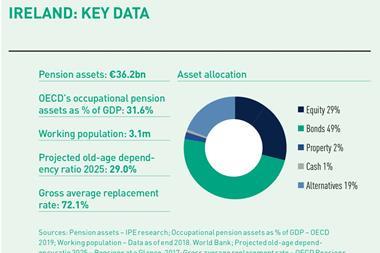The Irish government has decided on and published key elements of the design of its new auto-enrolment defined contribution (DC) pension savings system scheduled to come onstream by 2022.
Most of the elements are based on the proposals that were set out in the government’s “strawman” document published last year.
This was followed by a wide-ranging public consultation process that included contributions from experts internationally, as well as economic analysis by Ireland’s Economic and Social Research Institute.
Regina Doherty, minister for employment affairs and social protection, said the decisions that had been taken by the government were underpinned by the principle that the system “first and foremost operates in the best interests of savers”.
She highlighted the ‘pot-follows-member’ design as a key feature of the auto-enrolment system.
“This means that an employee’s pension contributions will be collected in the same pension ‘pot’ even when an employee changes employer, or if the employee has multiple employers,” she said. “This is one of the critical lessons that we learned from examining similar systems internationally.”
Key provisions include:
* Automatic enrolment to apply to all those in employment between 23 and 60 and earning at least €20,000 per annum and not in an equivalent employer’s scheme;
* Opt-in for employees under 23 or over 60, or earning under €20,000 p.a.;
* Contributions are compulsory for the first six months of membership, followed by a two-month opt-out period and some limited savings suspension periods;
* Employers have to make a matching (but tax-deductible) contribution at a specified rate, with a qualifying earnings ceiling of €75,000;
* Minimum contributions start at 1.5% of salary, increasing by 1.5 percentage points every three years to a maximum of 6% at the start of Year 10;
* The state will set up a Central Processing Authority (CPA) to approve providers and collect and distribute contributions;
* Employees to choose their provider (if not, the CPA will do so), achieving a “pot follows member” approach;
* Providers must offer a limited number of standard investment choices, including a default;
* Providers’ charges for administration and investment capped at 0.5%.
The government is sticking to 2022 as the start date for auto-enrolment, in spite of failing to meet most of its interim deadlines by the start of 2019.
Timeline questioned
Jerry Moriarty, chief executive, Irish Association of Pension Funds (IAPF), said: “Experience elsewhere shows auto-enrolment is effective in increasing coverage. The targeted contribution rates go some way towards achieving a reasonable level of adequacy.”
However, he added: “It is good that it is moving on, but 2022 still seems ambitious, particularly with some key decisions to be made.”
He said one of these decisions is the nature of the state contribution: “Strawman suggested a direct contribution, but it might be done by tax relief.”
Another of his reservations was that the operation of the CPA is still “somewhat unclear”.
Moriarty said: “Putting the CPA in place is the first key step as they will be approving providers, setting the criteria for providers and will also need the infrastructure to collect contributions. That will be challenging in order to have the first employees enrolled in 2022.”
Meanwhile, the exemption from providing auto-enrolment for members of an existing scheme which meets prescribed minimum standards and contribution levels will be key for pension schemes, he warned.
Moriarty said: “The issue for existing schemes will be what those prescribed minimum standards will be, and many schemes may need to increase their contribution levels.”
Furthermore, he observed: “There is still detail required on who is covered, such as when and how often that is determined. It has the potential to be reasonably complex, particularly with issues like suspensions.”








No comments yet